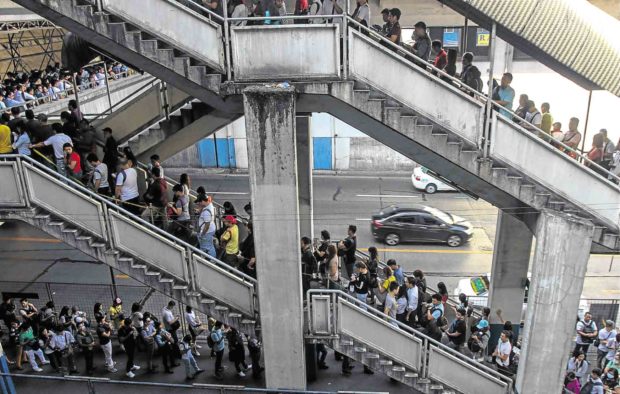
LONG AND WINDING LINE A technical problem that hit one of the MRT 3 trains in February this year strands hundreds of passengers. —JAM STA ROSA
Compared to the same period in 2016 and 2017, the number of unloading incidents reported this year by Metro Manila’s busiest light rail system, the Metro Rail Transit (MRT) 3, has dropped by around 80 to 90 percent.
According to data presented by the MRT 3 management, the cases of off-loading — in which passengers were forced to alight from a train due to disruptions in operations — went down to just 56 from January to November this year.
The figure was a marked improvement from the 440 and 562 incidents recorded during the same months in 2017 and 2016, respectively.
At least nine of the 56 unloading incidents happened in February when the number of functioning MRT 3 trains went down to a single digit.
11-minute wait
At 5 p.m. on Feb. 12, there were just seven operational trains, resulting in an 11-minute wait for passengers at the different stations.
Normally, the MRT 3 should have 15 trains running during rush hour and 12 trains at off-peak hours.
Due to the deterioration in services and the long wait in between trains, ridership was drastically affected.
In February, the MRT 3 ferried close to 259,000 passengers, a steep drop from its daily average of 463,000 passengers in 2017.
Things, however, improved in April as the number of operational trains went up once more to 15 with the arrival of much-needed spare parts.
The MRT 3’s longest glitch-free streak was 31 days until an electrical failure on Nov. 17 led to the off-loading of 650 passengers at Gil Puyat station.
The train system also recorded 17 instances of service interruptions that did not lead to the unloading of passengers.
Continuous maintenance
The MRT 3 management attributed the train system’s better performance to its staff’s continuous maintenance work.
However, the improvements could also be traced to the return of Sumitomo, the MRT 3’s original maintenance provider, for the implementation of a 43-month rehabilitation project.

